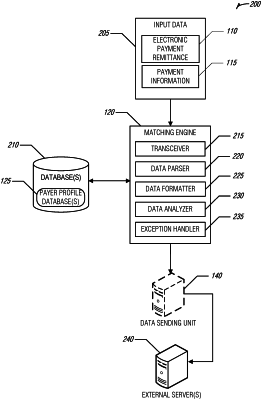| CPC G06Q 20/102 (2013.01) [G06F 16/9535 (2019.01)] | 20 Claims |

|
1. A method performed by a computing system executing instructions on at least one hardware processor, the method comprising:
receiving, by the at least one hardware processor, a first electronic remittance corresponding to a first electronic payment directed to a first payee;
determining, by the at least one hardware processor, that the first electronic remittance is in a first, unrecognized format for which there is not an exception-handling rule among a set of one or more exception-handling rules that are stored in a database, and responsively presenting, by the at least one hardware processor, to at least one user associated with the first payee, a user interface for matching electronic remittances to electronic payments;
receiving, by the at least one hardware processor, via the presented user interface, field-mapping information that maps at least one data field in the first format to at least one data field in a second, recognized format;
storing, by the at least one hardware processor, a new exception-handling rule in the set of one or more exception-handling rules in the database, the new exception-handling rule comprising the received field-mapping information;
receiving, by the at least one hardware processor, a second electronic remittance corresponding to a second electronic payment directed to the first payee;
determining, by the at least one hardware processor, that the second electronic remittance is in the first format, and responsively using the received field-mapping information in the new exception-handling rule in the database to convert the second electronic remittance to the second format by mapping the at least one data field in the first format to the at least one data field in the second format;
matching, by the at least one hardware processor, the converted second electronic remittance to the second electronic payment; and
providing, by the at least one hardware processor, to a payee computing system associated with the first payee, a payment file that indicates a match between the second electronic remittance and the second electronic payment.
|